I’m always fascinated to learn more about how works of art come into being, be it comics, books, films or any other medium; I find it often informs my reading of a text more, allowing me to appreciate more elements and aspects of it. One of the pleasures of editing this blog is that sometimes I get to ask some of our creative chums to tell us a bit about their new work and to take us through some of it in our Director’s Commentary posts.
For this first Commentary of 2012 I’m quite delighted to be welcoming to the blog a writer who may be making her graphic novel debut but who is certainly no stranger to other forms of writing and certainly intimately familiar with the lovely world of literature. Please welcome Doctor Mary Talbot, who tells us about one of the books that has been on my Must Read radar for several month, ever since her husband and collaborator on the book, Dotter of Her Father’s Eyes, was kind enough to show me some pages last year.
I know quite a few of you are also looking forward to reading Dotter, which is published by Cape at the start of February, so without further ado I will hand over to Mary and Bryan to tell us more about what promises to be an unusual and fascinating work combining biographical elements, literature, gender, history, society and more…
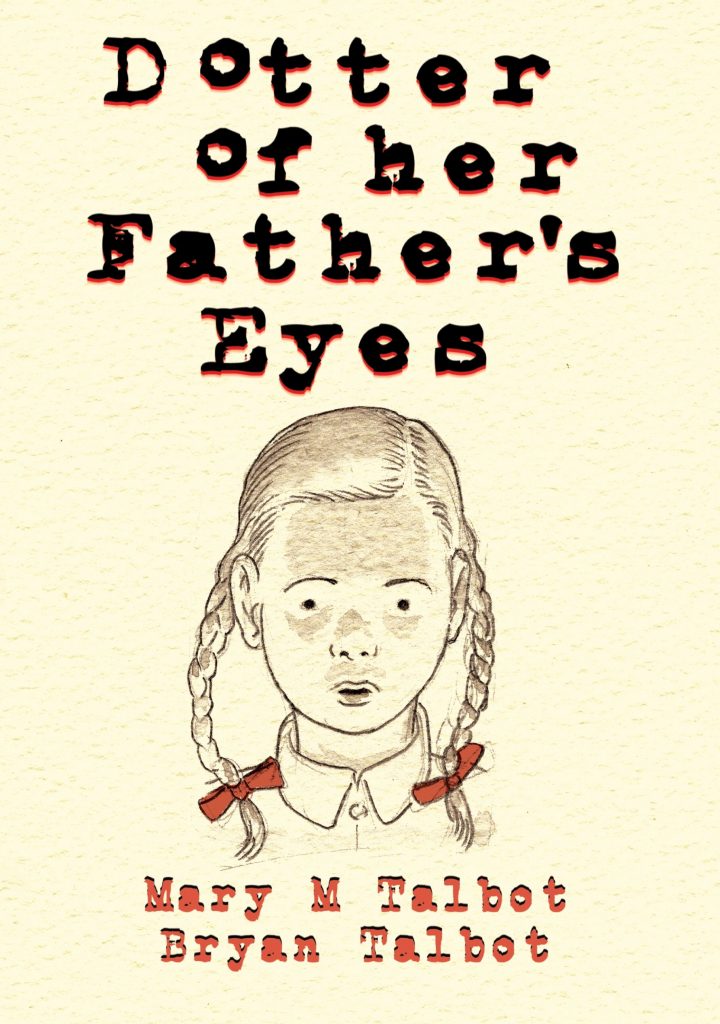
Dotter of her Father’s Eyes presents two coming-of-age stories, taking place at different points in the twentieth century. By intertwining these stories, I explore aspects of social history: gender politics and social expectations, shifting notions about ‘acceptable’ behaviour.
The idea for the book started when I took early retirement, giving me more time to write. Bryan suggested I try my hand at autobiographical writing, producing a graphic novel script that he would illustrate. Some previous plans of his for a collaboration had sadly fallen through, with the untimely death of the Australian narrative poet, Dorothy Porter. He suggested a couple of draft titles: ‘James Joyce and Me’ and ‘What a Piece of Work’ (actually the title of one of Porter’s books). To be honest, I was a bit bemused at the prospect of autobiography. ‘Whoever would want to know?’ I thought, ‘So, my father was a Joycean scholar, so what?’ I gave it some thought anyway and, vaguely aware that Joyce had a daughter, I looked into that as a possible angle. As it happened a biography of Lucia Joyce had come out not long before (Carol Shloss’s Lucia Joyce: To Dance at the Wake, published Farrar Straus Giroux). I was blown away by the tragedy of Lucia’s story – that was what I was interested in writing about. It’s that biography that I’m reading in this train journey scene, part of the opening sequence:
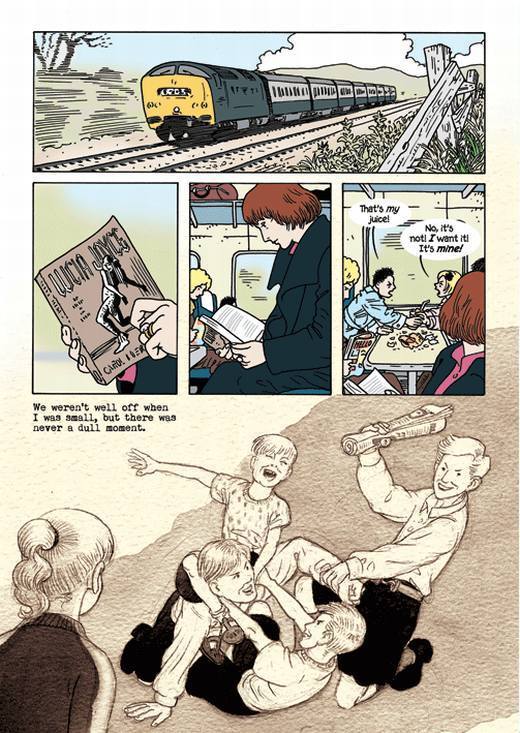
As you can see, there’s a transition from present to remembered past. I love the colour/sepia contrast. In the script the description for the bottom panel was just something like ‘heap of boys playfighting’. Bryan introduced the small girl watching them. It improves the character focus a lot. He did that with quite a few panels – adding the young me as the viewing subject.

I really enjoyed evoking life in northwest England in the 1950s and 60s. I wanted to bring out how different it was, how much has changed. Television was still quite a novelty; not many homes had one. I nearly included my first experience of the moving image at age five: traumatised by going to see Bambi! It didn’t fit in, though. Shame.
The nuances of class differences were something else I wanted to evoke. Those fine distinctions, between people living in the same neighbourhood, must totally mystify outsiders: taste in interior décor, eating habits, the presence of books.
We added a few footnote comments. The first of them is on this page. I wasn’t keen on the way Bryan had drawn my mother – in an apron as worn by the stereotypical 1950s American housewife! So we made a joke of it. I like the way it highlights the collaboration and adds an element of meta-textual commentary.
Gender politics is a key concern of the book. In the two storylines – Lucia’s and my own – I show how gender expectations constrain girls and women. Lucia matures to become an accomplished performer of modern dance. This makes her altogether too modern for her mother, who dislikes her aspirations for a professional life and frequently belittles them. Father and daughter are closer, but he is apparently oblivious to her plans. The consequences for Lucia are tragic. In my case, the fact that boys and girls are supposed to be and do different things was first forced on me when I started school. This is what we’ve represented on Page 17 here:
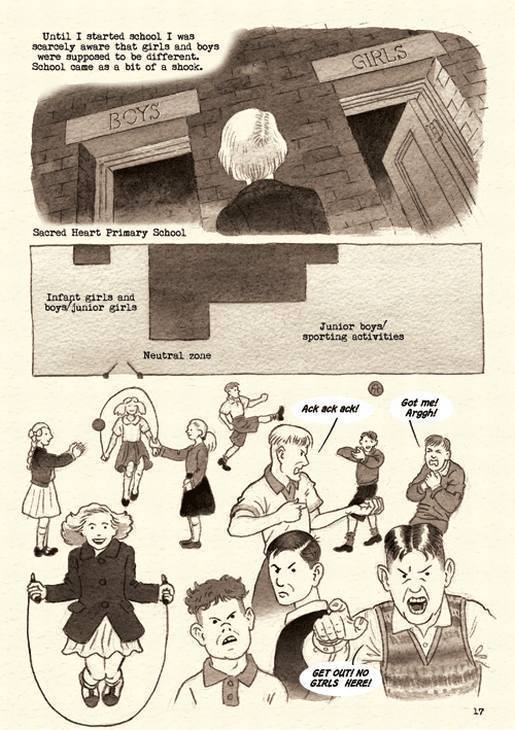 It’s odd – I used to use this scenario in seminars, talking about gender segregation with students (I taught on gender and language for decades). I could have done with this page as a visual aid! At the school I went to, difference was quite literally inscribed in stone.
It’s odd – I used to use this scenario in seminars, talking about gender segregation with students (I taught on gender and language for decades). I could have done with this page as a visual aid! At the school I went to, difference was quite literally inscribed in stone.
Bryan and I both grew up in Lancashire – Wigan, to be precise – and my schooling was Catholic. A distinctive feature of that particular cultural milieu in the 1950s and 60s was the annual ‘Walking Day’, as represented on Page 22. Here’s also some of the visual reference Bryan was drawing on to produce the page:
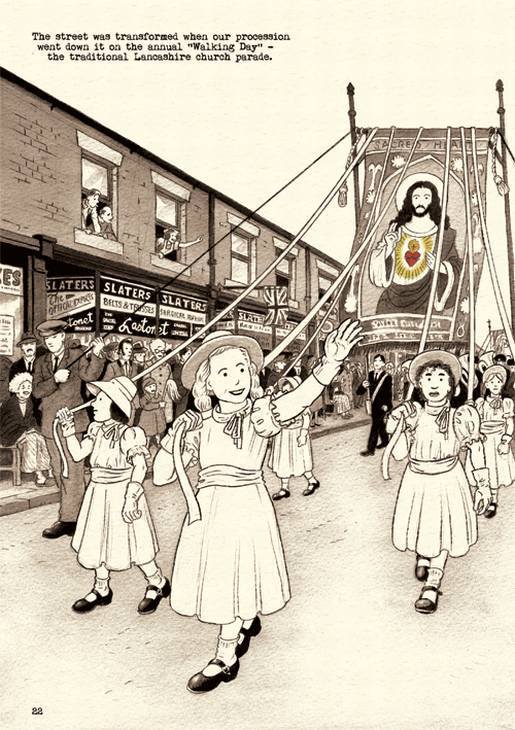
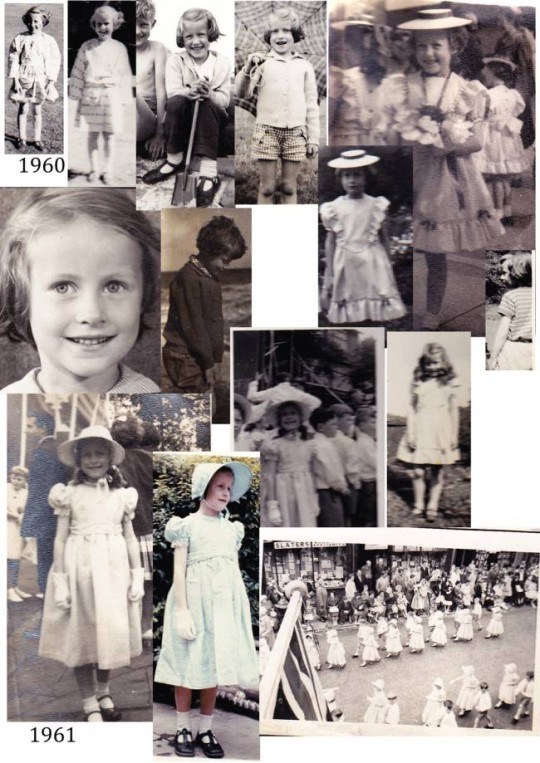 After scrounging old photo albums from my family, I scanned quantities of pictures that Bryan then made selections from. The collage of photo fragments is what he worked from at the drawing board.
After scrounging old photo albums from my family, I scanned quantities of pictures that Bryan then made selections from. The collage of photo fragments is what he worked from at the drawing board.
Bryan was making scripting suggestions from the start, but it was once he started bringing the script to life on the page that his enrichment of the story really started to shine though. The staircase page is a fine example of how his visualisations went beyond my expectations. It’s a lovely piece of design, while telling the story beautifully.

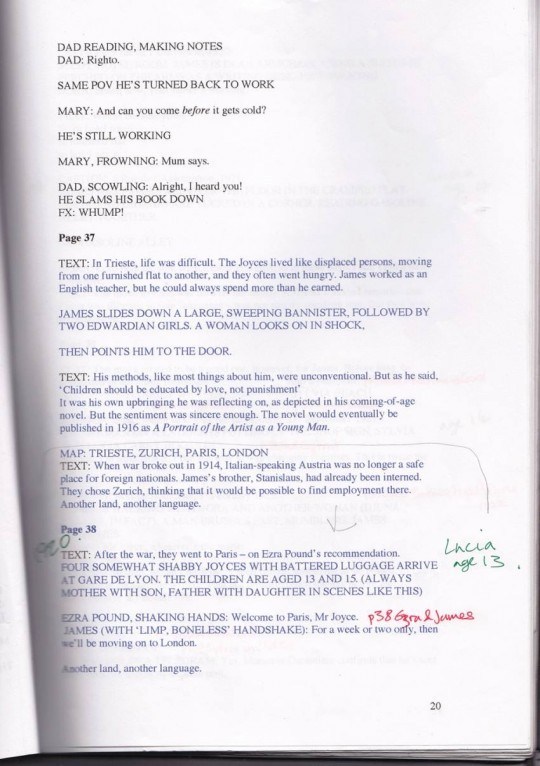
I had a lot of fun researching les années folles in 1920s Paris. Lucia and her family were right there in the thick of things, living in the centre of Paris. The place must have been positively thrumming with creative activity. Lucia developed a passion for modern, expressive dancing, eventually performing it herself. One of her teachers was Margaret Morris (a pioneer of dance as therapy and still a big name today). She became something of a role model. The page below shows Lucia seeing her dance for the first time:

Lucia’s tragic story must have been getting to me, because I actually dreamed this image! What astonished me was that Bryan actually drew it, on the basis of my two or three line description (and a certain amount of arm waving).
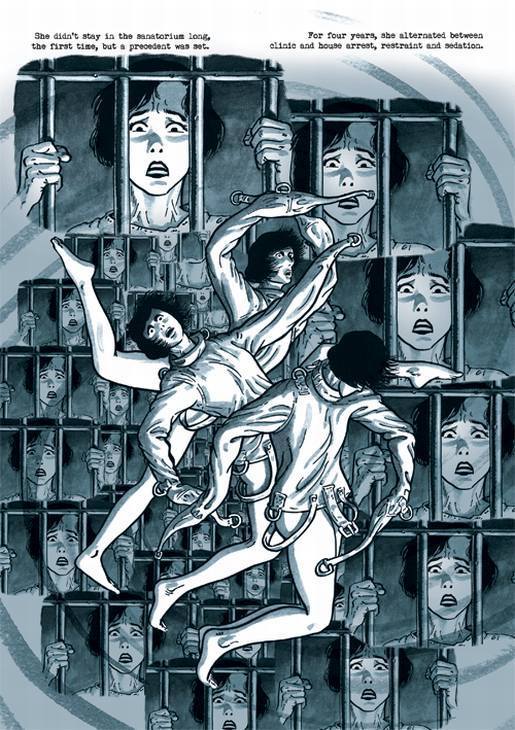 There’s a mass of biographical material available on James Joyce and his family, but there isn’t that much directly about Lucia, apart from the biography by Shloss I’ve mentioned. I needed to maintain focus on Lucia not her father or others in the family. They were such a dysfunctional family, it was hard not to get sidetracked. Then I had decisions about how much to include on Lucia’s mental illness, incarcerations and treatments. Eventually I decided to represent them over just a few pages, as a single cataclysmic event.
There’s a mass of biographical material available on James Joyce and his family, but there isn’t that much directly about Lucia, apart from the biography by Shloss I’ve mentioned. I needed to maintain focus on Lucia not her father or others in the family. They were such a dysfunctional family, it was hard not to get sidetracked. Then I had decisions about how much to include on Lucia’s mental illness, incarcerations and treatments. Eventually I decided to represent them over just a few pages, as a single cataclysmic event.
Bryan adds:
I developed a style that I thought suited the material and the artwork is coded so that the reader is in no doubt as to which thread they are reading. The few present-day sequences are drawn in clear line style with flat colours. The autobiographical sequences are in soft B pencil and watercolour wash on textured watercolour paper, with touches of spot colour. In Photoshop, I made the washes sepia and the paper pale yellow. The Joyce family sequences are inked with a dip pen and shaded with a watercolour wash, tinted blue in Photoshop, on smooth paper. I used spot colour in Mary’s sections to approximate the way that memory renders some things more vivid that others.
I had to do a lot of research in order to evoke the atmosphere of Paris of the 20s and 30s, and Lancashire in the 50s and 60s. I also, of course, could draw on my own memories of Wigan and of Mary’s family home.
Regarding Page 37, mentioned by Mary above, the staircase was based on one I’d seen recently inside the Courtauld Institute of Art, where I’d attended an academic conference on comics.

Dotter of Her Father’s Eyes by Mary and Bryan Talbot is published in February by Jonathan Cape (UK) and Dark Horse (US). We would like to thank Mary and Bryan for kindly taking the time to tell us more about the book; you can also learn more from Mary’s own site here and Bryan’s site here.
[amazon_link asins=’0224096087,0224102346,0224097865,1787330486′ template=’ProductCarousel’ store=’downthetubes’ marketplace=’UK’ link_id=’abd893a8-fe5f-42d1-95f7-f6a7a550198a’]
Mary and Bryan will be doing a signing in London’s fine Orbital Comics on 3rd February 2012 at 5pm and Orbital is also hosting an art exhibition from the book from 2nd February to 2nd March 2012.

Joe has been a bookseller since the early 1990s, with a special love for comics, graphic novels and science fiction. He has written for The Alien Online, created & edited the Forbidden Planet Blog and chaired numerous events for the Edinburgh International Book Festival. He’s more or less house-trained.
Categories: Creating Comics, downthetubes News, Features
 Crowdfunding Spotlight: Who Killed Nessie? A Quick Chat with Paul Cornell & Rachael Smith
Crowdfunding Spotlight: Who Killed Nessie? A Quick Chat with Paul Cornell & Rachael Smith  Who remembers Jerry Siegel’s British superheroes,”Gadgetman and Gimmick-Kid”?
Who remembers Jerry Siegel’s British superheroes,”Gadgetman and Gimmick-Kid”?  Exclusive: Creating Comics – Chris Weston talks “Time Breakers” and “Paranoid Gardens”
Exclusive: Creating Comics – Chris Weston talks “Time Breakers” and “Paranoid Gardens”  Catching up with the Comics Laureate! An interview with Bobby Joseph
Catching up with the Comics Laureate! An interview with Bobby Joseph